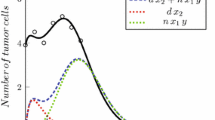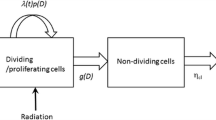Abstract
Purpose
This work aimed to develop a population PK/PD tumor-in-host model able to describe etoposide effects on both tumor cells and host in Walker-256 tumor-bearing rats.
Methods
Etoposide was investigated on thirty-eight Wistar rats randomized in five arms: two groups of tumor-free animals receiving either placebo or etoposide (10 mg/kg bolus for 4 days) and three groups of tumor-bearing animals receiving either placebo or etoposide (5 or 10 mg/kg bolus for 8 or 4 days, respectively). To analyze experimental data, a tumor-in-host growth inhibition (TGI) model, based on the Dynamic Energy Budget (DEB) theory, was developed. Total plasma and free-interstitial tumor etoposide concentrations were assessed as driver of tumor kinetics.
Results
The model simultaneously describes tumor and host growths, etoposide antitumor effect as well as cachexia phenomena related to both the tumor and the drug treatment. The schedule-dependent inhibitory effect of etoposide is also well captured when the intratumoral drug concentration is considered as the driver of the tumor kinetics.
Conclusions
The DEB-based TGI model capabilities, up to now assessed only in mice, are fully confirmed in this study involving rats. Results suggest that well designed experiments combined with a mechanistic modeling approach could be extremely useful to understand drug effects and to describe all the dynamics characterizing in vivo tumor growth studies.







Similar content being viewed by others
Abbreviations
- AIC:
-
Akaike’s information criterion
- AUC:
-
Area under the curve
- BIC:
-
Bayesian information criterion
- BQL:
-
Below limit of quantification
- BWL:
-
Body weight loss
- CV:
-
Coefficient of variation
- DEB:
-
Dynamic energy budget
- GOF:
-
Goodness of fit
- i.v.:
-
Intravenous
- NPDE:
-
Normalized prediction distribution errors
- PD:
-
Pharmacodynamic
- PK:
-
Pharmacokinetic
- RSE:
-
Residual standard error
- s.c.:
-
Subcutaneously
- TGI:
-
Tumor Growth Inhibition
- VPC:
-
Visual predictive check
- W256:
-
Walker-256
References
Carrara L, Lavezzi SM, Borella E, De Nicolao G, Magni P, Poggesi I. Current mathematical models for cancer drug discovery. Expert Opin Drug Discovery. 2017;12(8):785–99.
Bonate PL. Modeling tumor growth in oncology. In: Pharmacokinetics in drug development: Springer; 2011. p. 1–19.
Ribba B, Holford NH, Magni P, Trocóniz I, Gueorguieva I, Girard P, et al. A review of mixed-effects models of tumor growth and effects of anticancer drug treatment used in population analysis. CPT: Pharmacometrics & Systems Pharmacology. 2014;3(5):1–10.
Benzekry S, Lamont C, Beheshti A, Tracz A, Ebos JM, Hlatky L, et al. Classical mathematical models for description and prediction of experimental tumor growth. PLoS Comput Biol. 2014;10(8):e1003800.
Rajman I. PK/PD modelling and simulations: utility in drug development. Drug Discov Today. 2008;13(7):341–6.
Simeoni M, Nicolao GD, Magni P, Rocchetti M, Poggesi I. Modeling of human tumor xenografts and dose rationale in oncology. Drug Discov Today Technol. 2013;10(3):e365–72.
Bernard A, Kimko H, Mital D, Poggesi I. Mathematical modeling of tumor growth and tumor growth inhibition in oncology drug development. Expert Opin Drug Metab Toxicol. 2012;8(9):1057–69.
Simeoni M, Magni P, Cammia C, De Nicolao G, Croci V, Pesenti E, et al. Predictive pharmacokinetic-pharmacodynamic modeling of tumor growth kinetics in xenograft models after administration of anticancer agents. Cancer Res. 2004;64(3):1094–101.
Rocchetti M, Poggesi I, Germani M, Fiorentini F, Pellizzoni C, Zugnoni P, et al. A pharmacokinetic-pharmacodynamic model for predicting tumour growth inhibition in mice: a useful tool in oncology drug development. Basic Clin Pharmacol Toxicol. 2005;96(3):265–8.
Garattini S. Pharmacokinetics in cancer chemotherapy. Eur J Cancer. 2007;43(2):271–82.
Trédan O, Galmarini CM, Patel K, Tannock IF. Drug resistance and the solid tumor microenvironment. J Natl Cancer Inst. 2007;99(19):1441–54.
Grantab R, Sivananthan S, Tannock IF. The penetration of anticancer drugs through tumor tissue as a function of cellular adhesion and packing density of tumor cells. Cancer Res. 2006;66(2):1033–9.
Terranova N, Tosca EM, Pesenti E, Rocchetti M, Magni P. Modeling tumor growth inhibition and toxicity outcome after administration of anticancer agents in xenograft mice: a dynamic energy budget (DEB) approach. J Theor Biol. 2018;450:1–14.
Van Leeuwen I, Kelpin F, Kooijman S. A mathematical model that accounts for the effects of caloric restriction on body weight and longevity. Biogerontology. 2002;3(6):373–81.
Van Leeuwen I, Zonneveld C, Kooijman S. The embedded tumour: host physiology is important for the evaluation of tumour growth. Br J Cancer. 2003;89(12):2254–63.
Pigatto MC, Roman RM, Carrara L, Buffon A, Magni P, Dalla Costa T. Pharmacokinetic/ pharmacodynamic modeling of etoposide tumor growth inhibitory effect in Walker-56 tumor-bearing rat model using free intratumoral drug concentrations. Eur J Pharm Sci. 2017;97:70–8.
Kaul S, Igwemezie LN, Stewart DJ, Fields SZ, Kosty M, Levithan N, et al. Pharmacokinetics and bioequivalence of etoposide following intravenous administration of etoposide phosphate and etoposide in patients with solid tumors. J Clin Oncol. 1995;13(11):2835–41.
Toffoli G, Corona G, Sorio R, Robieux I, Basso B, Colussi AM, et al. Population pharmacokinetics and pharmacodynamics of oral etoposide. Br J Clin Pharmacol. 2001;52(5):511–9.
Brazil. Lei 11.794/2008: Procedimentos para Uso Cientifico de Animais; 2008. CXLV, 196, 1-2. Diario Oficial da Uniao, Secao 1 de 9 de outubro de 2008.
Brazil. Ministerio de Ciencia, Tecnologia e Inovacao Conselho Nacional de Controle de Experimentacao Animal; 2013. -CONCEA. Diretriz Brasileira para o cuidado e a utilizacao de animais para fins cientificos e didaticos- DBCA. Brasilia - DF.
NCI. 2012 Frederick ACUC Guidelines Involving Experimental Neoplasia Proposals in Mice and Rats; https://es.scribd.com/document/139069470/ACUC14 (accessed 0.10.3.14).
Pigatto MC, de Araujo BV, Torres BGS, Schmidt S, Magni P, Dalla Costa T. Population pharmacokinetic modeling of etoposide free concentrations in solid tumor. Pharm Res. 2016;33(7):1657–70.
Tuntland T, Ethell B, Kosake T, Blasco F, Zang RX, Jain M, et al. Implementation of pharmacokinetic and pharmacodynamic strategies in early research phases of drug discovery and development at Novartis Institute of Biomedical Research. Front Pharmacol. 2014;5:174.
Li X, Yun JK, Choi JS. Effects of morin on the pharmacokinetics of etoposide in rats. Biopharm Drug Dispos. 2007;28(3):151–6.
Lee CK, Ki SH, Choi JS. Effects of oral curcumin on the pharmacokinetics of intravenous and oral etoposide in rats: possible role of intestinal CYP3A and P-gp inhibition by curcumin. Biopharm Drug Dispos. 2011;32(4):245–51.
Kooijman SALM. Dynamic energy budgets in biological systems. Cambridge university press; 1993.
Kooijman SALM. Dynamic energy and mass budgets in biological systems. Cambridge university press 2000.
Kooijman SALM. Quantitative aspects of metabolic organization: a discussion of concepts. Philosophical Transactions of the Royal Society of London B: Biological Sciences. 2001;356(1407):331–49.
Lixoft. Monolix version 2016 R; http://lixoft.com/products/monolix/.
Lavielle M. Mixed effects models for the population approach: models, tasks, methods and tools. CRC press; 2014.
Hollingshead MG. Antitumor efficacy testing in rodents. JNCI: Journal of the National Cancer Institute. 2008;100(21):1500–10.
Tannock IF, Lee CM, Tunggal JK, Cowan DS, Egorin MJ. Limited penetration of anticancer drugs through tumor tissue: a potential cause of resistance of solid tumors to chemotherapy. Clin Cancer Res. 2002;8(3):878–84.
Author information
Authors and Affiliations
Corresponding author
Additional information
Publisher’s note
Springer Nature remains neutral with regard to jurisdictional claims in published maps and institutional affiliations.
Rights and permissions
About this article
Cite this article
Tosca, E.M., Pigatto, M.C., Dalla Costa, T. et al. A Population Dynamic Energy Budget-Based Tumor Growth Inhibition Model for Etoposide Effects on Wistar Rats. Pharm Res 36, 38 (2019). https://doi.org/10.1007/s11095-019-2568-9
Received:
Accepted:
Published:
DOI: https://doi.org/10.1007/s11095-019-2568-9




